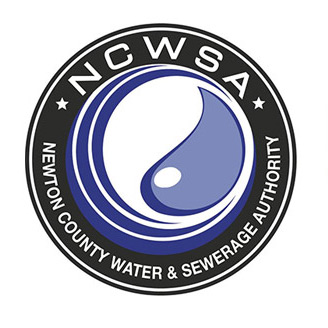Water Quality Report

Our Water Quality Report for 2024 ![]()
Since 1970, the Newton County Water & Sewerage Authority
has provided clean, safe drinking water throughout the
unincorporated areas of Newton County. We purchase
treated water for drinking and potable uses from the Newton
County Board of Commissioners, who own and operate
Cornish Creek WTP/Lake Varner Water Supply System
including an 820-acre drinking water and recreational
reservoir containing approximately 4 Billion Gallons. The
Alcovy River is the source water for Newton County. Raw
water is diverted from the river and pumped to Lake Varner
and one smaller reservoir. Located on the Lake Varner
Reservoir site, the award-winning Cornish Creek WTP filters
and disinfects up to 25 Million Gallons per Day, transforming
the source water into clean, safe drinking water for nearly
110,000 citizens in Newton County.
As a customer of the NCWSA system, feel confident that
Newton County is drought-ready, having the ability to stretch
our water supply at Lake Varner from 6 to 8 months under
record drought conditions.
Contaminants and potential pollution sources tributary to
the Alcovy River and the Reservoirs are identified in a Source
Water Assessment Plan (SWAP) updated in June 2021. From
the SWAP, we find that the overall susceptibility of the source
water is rated medium. Threats to our source water quality
include agricultural waste ponds, secondary paved roads,
and sediment-laden runoff. Recommendations for Alcovy
watershed protection contained in the Assessment help to
ensure that our customers will be provided with the best
quality water in the future.
About Our Drinking Water
Newton County’s Cornish Creek WTP has won the State of
Georgia’s Best Operated Water Treatment Facility for 2022.
In Georgia, sources of drinking water (both tap and
bottled water) include rivers, lakes, streams, ponds,
reservoirs, springs, and wells. As rain, storm water runoff,
and groundwater flows over land or under ground on its
way to our streams and rivers, it dissolves naturally occurring
minerals and, in some cases, radioactive material,
and can pick up substances resulting from the presence
of animals or from human activity. Contaminants that
may be present in source water include:
• Microbial contaminants, bacteria, viruses,
including Cryptosporidium, which may pass
through or leave and municipal or industrial
wastewater spills, septic systems, agricultural
livestock operations, and wildlife areas,
• Inorganic contaminants, such as salts and metals
which can be naturally occurring or result from
urban storm water runoff, industrial or domestic
wastewater discharges, oil and gas production,
mining, and farming,
• Pesticides and herbicides, which may come from a
variety of sources such as agriculture, urban storm water
runoff, and residential uses,
• Organic chemical contaminants, including synthetic and
volatile organic chemicals, which are by-products of
industrial processes and petroleum production, and
come from gas stations, urban storm water runoff, and
septic systems, and,
• Turbidity, a measure of the water’s clarity, has no known
health effects. However, turbidity can interfere with
disinfection and provide a medium for microbial growth.
Turbidity may indicate the presence of disease-causing
organisms. These organisms include bacteria, viruses,
and parasites that can cause nausea, cramps, diarrhea,
and headaches.
• Radioactive contaminants, which can be naturally
occurring, or be the result of oil and gas production
and mining activities.
• Elevated levels of lead can cause serious health
problems, especially for pregnant women and young
children. Lead in drinking water is primarily from
materials and components associated with service lines
and home plumbing. NCWSA is responsible for
providing high quality drinking water, but cannot control
the variety of materials used in plumbing components.
When water taps have been closed for several hours,
minimize the potential for lead exposure by flushing the
tap for 30 seconds to 2 minutes before using the water
for drinking or cooking. Concerned about lead in
water? You may wish to have your water tested.
Information on lead in drinking water, testing
methods, and steps to minimize exposure is
available from the Safe Drinking Water Hotline,
or at http://www.epa.gov / safewater / lead.
To ensure that tap water is safe to drink, the U.S. Environmental Protection
Agency (EPA) prescribes regulations which limit the number and
type of contaminants present in treated water provided by U.S. water
systems. Federal Food and Drug Administration Agency regulations
establish limits for contaminants in bottled water which must provide the
same protections for consumers.
Drinking water, including bottled water, may reasonably be expected to
contain low levels of some contaminants. The presence of contaminants
does not necessarily indicate that the water poses a health risk.
Certain individuals may be more vulnerable to contaminants in drinking
water than the general population. Elderly persons and infants are more
vulnerable along with immuno-compromised persons, those undergoing
chemotherapy, organ transplant recipients, those with HIV / AIDS, or
other immune system disorders can be particularly at risk for infections.
At-risk persons should seek advice from their health care providers about
drinking water. The EPA and the Center for Disease Control (CDC)
maintain guidelines on the appropriate means to lessen the risk of
infection by microbial contaminants. More information is available from
Safe Drinking Water Hotline at (800) 426-4791.
11325 Brown Bridge Road
Covington, GA 30016
(770) 787-1375 • www.ncwsa.us
